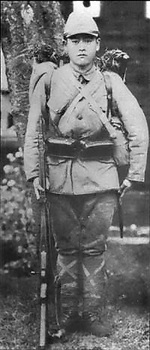

Most of the Arisakas with surviving insignia are in Japan, though there are a few remaining on samples taken as war trophies before the surrender, and those captured by Chinese forces. forces has been found that required the defacing. There are conflicting claims that this was done on the orders of the Imperial Japanese Military prior to surrender, however it is generally accepted by most historians that the imperial chrysanthemums were ground off the rifles on the orders from General Douglas MacArthur, the commander of occupation forces at that time. To date, no documentation from either Japanese or U.S. The imperial ownership seal, a 16-petal Chrysanthemum known as the Chrysanthemum Flower Seal stamped upon the top of the receiver in all official imperial-issue rifles, has often been defaced by filing, grinding, or stamping on surviving examples. Additional 6.5x50mm SR ammunition was, however, produced in China for use in their captured rifles. Since most Imperial Japanese Armory contents were thrown into Tokyo Harbor after the signing of the surrender, spare ammunition also became rare.

However, after the Japanese surrender in the summer of 1945, manufacture of rifles and ammunition stopped abruptly, and the Arisaka quickly became obsolete. Many captured Arisaka rifles were employed by neighboring countries both during and after World War II, in places such as China, Thailand and Cambodia.

The Czech Legions that fought in the Russian Revolution were almost entirely armed with Type 30s and 38s. Prior to World War II, Arisakas were used by the British Navy and Russian Army, in Finland and Albania. The Arisaka bolt-action service rifle was used everywhere in the Imperial Japanese Army and the Imperial Japanese Navy. Near the end of World War II, last-ditch ersatz models were being made in various cost-cutting feature variations with the goal of cheaply bolstering the imperial armed forces for example, the ovoid bulb-shaped bolt of earlier runs were replaced by a smaller and utilitarian cylindrical shape, the handguard on the barrel was omitted, and crude fixed sights were fitted. The rear sights also featured folding horizontal extensions to give a degree of lead suitable for firing against aircraft. Some of the early issue Type 99 rifles were fitted with a folding wire monopod intended to improve accuracy in the prone position. 1085 with a carbon content of 0.80% to 0.90%, and a manganese content of 0.60% to 0.90%." During destructive tests, the Arisakas were shown to be stronger than the M1903 Springfield, Lee-Enfield, and Mauser rifles. The Arisaka's were also one of the only guns of the era to use polygonol rifling in its barrels, rather than the more traditional lands and grooves.

Tests on samples of Arisaka rifles conducted after the war showed that their bolts and receivers were constructed of carbon steel "similar to SAE steel grade No. Over the course of various wars several productions runs and variants were made, including the transition from the 6.5mm Type 38 cartridge to the larger 7.7mm Type 99, and the introduction of a paratrooper rifle that could be disassembled into two major parts for airborne operations. The Arisaka rifle was designed by Colonel Arisaka Nariakira (有坂 成章 1852–1915), who was later promoted to Lieutenant General and also received the title of Baron from Emperor Meiji, in 1907. DE-ACTIVATED TYPE 38/99 WW2 JAPANESE ARMY ARISAKA RIFLE


 0 kommentar(er)
0 kommentar(er)
